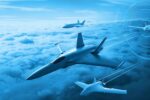The U.S. Air Force’s ambitious Next Generation Air Dominance (NGAD) program has reached a major milestone as Boeing begins production of the F-47—its entry into the sixth-generation fighter competition. While details remain classified, the announcement confirms that Boeing’s design is progressing toward a first flight target of 2028. This marks a significant step in reshaping future U.S. air superiority doctrine.
F-47 Confirmed as Boeing’s NGAD Contender
Boeing confirmed in September 2025 that it has entered the production phase for its F-47 air dominance platform at its St. Louis facility. The aircraft is being developed under the classified NGAD program—an effort to replace or augment the F-22 Raptor with a family of systems centered around a crewed sixth-generation fighter.
The designation “F-47” was revealed in internal USAF documentation and later corroborated by multiple defense sources. While unofficial renderings have circulated online since late 2024 showing tailless delta-wing designs with embedded engine intakes and reduced radar cross-sections (RCS), Boeing has not released any official imagery or specifications.
According to senior USAF officials speaking at AFA’s Air, Space & Cyber Conference in September 2025, Boeing’s prototype will incorporate advanced stealth shaping, adaptive cycle propulsion technology, and full-spectrum sensor fusion—all hallmarks of next-gen air superiority platforms.
Targeting First Flight by 2028
The timeline for first flight—set for no later than fiscal year 2028—aligns with previous statements from Air Force Secretary Frank Kendall that at least one NGAD prototype had already flown as early as 2020 under a technology demonstrator initiative. However, this new production phase signals transition from experimental validation to an acquisition-ready platform.
“We are moving from concept to capability,” said Lt Gen Dale White (PEO for Fighters and Advanced Aircraft), noting that multiple contractors are now building full-scale test articles under competitive prototyping contracts.
The Air Force plans to downselect to a single prime contractor by FY27 or FY28 following flyoff evaluations between competing designs—believed to include entries from Lockheed Martin (likely derived from its X-plane demonstrator) and Northrop Grumman alongside Boeing’s F-47.
Key Features: Stealth, AI Integration, and Manned-Unmanned Teaming
Although technical details remain highly classified under Special Access Programs (SAP), informed analysis based on open-source intelligence suggests several likely features of the F-47:
- Tailless design: For improved stealth across radar bands and reduced IR signature via embedded exhaust systems.
- Adaptive cycle engine: Likely powered by Pratt & Whitney XA100 or GE XA101 derivatives offering variable bypass ratios for both high thrust and fuel efficiency.
- Cognitive electronic warfare: AI-driven threat detection and response capabilities integrated into onboard mission systems.
- MUM-T compatibility: Designed to operate alongside Collaborative Combat Aircraft (CCA) drones such as those under development by Kratos and Anduril.
This modular “family-of-systems” approach is central to NGAD doctrine: a piloted core aircraft commanding swarms of autonomous CCAs optimized for ISR, suppression/destruction of enemy air defenses (SEAD/DEAD), or kinetic strike missions—all connected via secure mesh networks using resilient datalinks like MADL or potential SATCOM-based waveforms.
Boeing’s Strategic Position in Sixth-Gen Race
Boeing’s entry into this high-stakes competition marks both an industrial comeback and strategic pivot after losing out on several major tactical aircraft programs over the past two decades—including JSF (F-35) and B-21 Raider bomber contracts. The company has invested heavily in digital engineering infrastructure at its Phantom Works division to accelerate development cycles via model-based systems engineering (MBSE) tools.
Boeing also leads key unmanned combat initiatives such as Australia’s MQ-28 Ghost Bat loyal wingman project—which may inform CCA integration strategies with the F-47 platform domestically. Analysts suggest that lessons learned from Ghost Bat’s modular payload bays and AI autonomy stack could be leveraged in tandem with manned platforms like the F-47 for distributed lethality concepts.
Implications for Global Airpower Balance
The introduction of sixth-generation fighters like the F-47 will have profound implications on global deterrence dynamics—particularly vis-à-vis China’s J-X program (possibly J-25) and Russia’s ongoing MiG-LMFS efforts. Both adversaries are believed to be pursuing similar capabilities including stealthy tailless designs, directed energy weapons integration, and unmanned teaming concepts.
The U.S. Department of Defense plans to field operational NGAD squadrons by early-to-mid 2030s within Pacific-focused force posture realignments aimed at countering A2/AD environments across Taiwan Strait scenarios or South China Sea flashpoints. The survivability enhancements offered by platforms like the F-47 will be critical against layered IADS networks featuring S-500 class SAMs or PLA Navy carrier-based aviation threats.
Next Steps: Flyoff Evaluations Before Downselect
The coming years will see increased testing activity at ranges such as Edwards AFB or Groom Lake as each contractor finalizes their prototypes ahead of flyoff trials expected before FY28 budget lock-ins. These trials will assess not only kinematic performance but also interoperability with CCA drones; ability to penetrate contested environments; sensor fusion effectiveness; EW resilience; and lifecycle cost metrics under Digital Century Series acquisition models.
If successful through these gates, Boeing’s F-47 could enter Low Rate Initial Production (LRIP) before end-of-decade—with full-rate procurement ramp-up aligned with retirement timelines for legacy Raptors beginning circa FY32–FY35 depending on fleet health assessments.








